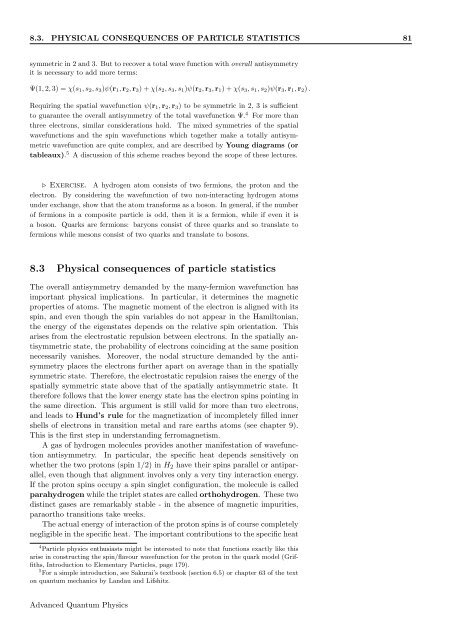Identical Particles - Theory of Condensed Matter
Identical Particles - Theory of Condensed Matter
Identical Particles - Theory of Condensed Matter
Create successful ePaper yourself
Turn your PDF publications into a flip-book with our unique Google optimized e-Paper software.
8.3. PHYSICAL CONSEQUENCES OF PARTICLE STATISTICS 81<br />
symmetric in 2 and 3. But to recover a total wave function with overall antisymmetry<br />
it is necessary to add more terms:<br />
Ψ(1, 2, 3) = χ(s1,s2,s3)ψ(r1, r2, r3)+χ(s2,s3,s1)ψ(r2, r3, r1)+χ(s3,s1,s2)ψ(r3, r1, r2) .<br />
Requiring the spatial wavefunction ψ(r1, r2, r3) to be symmetric in 2, 3 is sufficient<br />
to guarantee the overall antisymmetry <strong>of</strong> the total wavefunction Ψ. 4 For more than<br />
three electrons, similar considerations hold. The mixed symmetries <strong>of</strong> the spatial<br />
wavefunctions and the spin wavefunctions which together make a totally antisymmetric<br />
wavefunction are quite complex, and are described by Young diagrams (or<br />
tableaux). 5 A discussion <strong>of</strong> this scheme reaches beyond the scope <strong>of</strong> these lectures.<br />
⊲ Exercise. A hydrogen atom consists <strong>of</strong> two fermions, the proton and the<br />
electron. By considering the wavefunction <strong>of</strong> two non-interacting hydrogen atoms<br />
under exchange, show that the atom transforms as a boson. In general, if the number<br />
<strong>of</strong> fermions in a composite particle is odd, then it is a fermion, while if even it is<br />
a boson. Quarks are fermions: baryons consist <strong>of</strong> three quarks and so translate to<br />
fermions while mesons consist <strong>of</strong> two quarks and translate to bosons.<br />
8.3 Physical consequences <strong>of</strong> particle statistics<br />
The overall antisymmetry demanded by the many-fermion wavefunction has<br />
important physical implications. In particular, it determines the magnetic<br />
properties <strong>of</strong> atoms. The magnetic moment <strong>of</strong> the electron is aligned with its<br />
spin, and even though the spin variables do not appear in the Hamiltonian,<br />
the energy <strong>of</strong> the eigenstates depends on the relative spin orientation. This<br />
arises from the electrostatic repulsion between electrons. In the spatially antisymmetric<br />
state, the probability <strong>of</strong> electrons coinciding at the same position<br />
necessarily vanishes. Moreover, the nodal structure demanded by the antisymmetry<br />
places the electrons further apart on average than in the spatially<br />
symmetric state. Therefore, the electrostatic repulsion raises the energy <strong>of</strong> the<br />
spatially symmetric state above that <strong>of</strong> the spatially antisymmetric state. It<br />
therefore follows that the lower energy state has the electron spins pointing in<br />
the same direction. This argument is still valid for more than two electrons,<br />
and leads to Hund’s rule for the magnetization <strong>of</strong> incompletely filled inner<br />
shells <strong>of</strong> electrons in transition metal and rare earths atoms (see chapter 9).<br />
This is the first step in understanding ferromagnetism.<br />
A gas <strong>of</strong> hydrogen molecules provides another manifestation <strong>of</strong> wavefunction<br />
antisymmetry. In particular, the specific heat depends sensitively on<br />
whether the two protons (spin 1/2) in H2 have their spins parallel or antiparallel,<br />
even though that alignment involves only a very tiny interaction energy.<br />
If the proton spins occupy a spin singlet configuration, the molecule is called<br />
parahydrogen while the triplet states are called orthohydrogen. These two<br />
distinct gases are remarkably stable - in the absence <strong>of</strong> magnetic impurities,<br />
paraortho transitions take weeks.<br />
The actual energy <strong>of</strong> interaction <strong>of</strong> the proton spins is <strong>of</strong> course completely<br />
negligible in the specific heat. The important contributions to the specific heat<br />
4 Particle physics enthusiasts might be interested to note that functions exactly like this<br />
arise in constructing the spin/flavour wavefunction for the proton in the quark model (Griffiths,<br />
Introduction to Elementary <strong>Particles</strong>, page 179).<br />
5 For a simple introduction, see Sakurai’s textbook (section 6.5) or chapter 63 <strong>of</strong> the text<br />
on quantum mechanics by Landau and Lifshitz.<br />
Advanced Quantum Physics

















